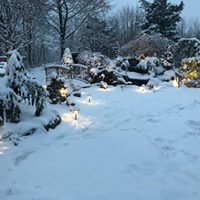Winterizing your koi pond.
 We at Hilltop Koi wrote this page because we have had people asking for advice on how they should go about winterizing their ponds. Honestly, it is very simple. You don’t need to panic or pay to have someone do it for you. All you need to know is a few basic things.
We at Hilltop Koi wrote this page because we have had people asking for advice on how they should go about winterizing their ponds. Honestly, it is very simple. You don’t need to panic or pay to have someone do it for you. All you need to know is a few basic things.
First of all I often get the question: Can I turn off my koi pond waterfall and/or filtration for the winter? The short answer is yes providing you do and know a few simple things.
 1st:
1st:
It is advisable that you don’t shut off the filtration until a few weeks after your last feeding to the koi fish. The reason for this is if you have a high load of fish in the pond, the pond may not be able to keep up with the breakdown of nutrients fast enough and lead to ammonia and nitrite. (The number one cause of fish disease and death.) You should stop feeding your koi when the water temperature has been consistently 50 degrees or below for awhile. (For a week or so, for example.) If you feed the koi when it is 50 or below you can actually kill your koi. The koi simply cannot digest their food that well any longer and it stays in their stomachs.
2nd:
We don’t recommend shutting of your filtration until the pond water is 50 degrees or lower. However, we definitely recommend shutting it off when the water is 40 degrees or below for several reasons. The first reason is so that cold water is not being constantly pulled to the bottom of the pond where it is warmer due to the depth of the pond. Your fish will be a lot more comfortable if they are deeper in the water in the ground because it is actually warmer there.
Koi can survive the winter even if the water gets as low as 32. However sometimes they will not do well at that temperature. Koi do not like to be much colder that 38 degrees. (We recommend a spot in the pond that is at least a minimum of 3 foot deep). The second reason is that you don’t loose pond water due to the formation of ice on the water falls.
Note: Little tip-sometimes leaving some leaves in the bottom of the pond at the deepest part until spring is a good idea. This way the koi have a place to hide and a little bit of insulation.
3rd:
If you are keeping your koi in the pond for the winter the main thing you need to do is to keep a hole in the ice after the filtration is shut down. This step is one of the most important. You can achieve this by simply adding a bubbler or de-icer. However, if you add a bubbler we recommend that you do not place it all the way at the deepest spot because, again, you will be pulling cold water to the bottom of the pond where the koi are trying to stay warmer.
4th:
If you have a pond that is shallower than 3 foot and do not bring your fish in for the winter, it may be a good idea to place a heater in the deepest part of the pond. We recommend enclosing the heater in a cage of some sort to prevent any fish from getting too close to the extreme heat that is being expelled.
That’s it! That’s the basics of what you need to know in order for your koi to survive the sometimes harsh winter environments. Of course all this information is going to vary depending on where you live and your particular pond build. Everything is relative to your individual situation. So if you have any further questions or are still unsure as to what to do for your particular pond, please do not hesitate to ask or call us.
